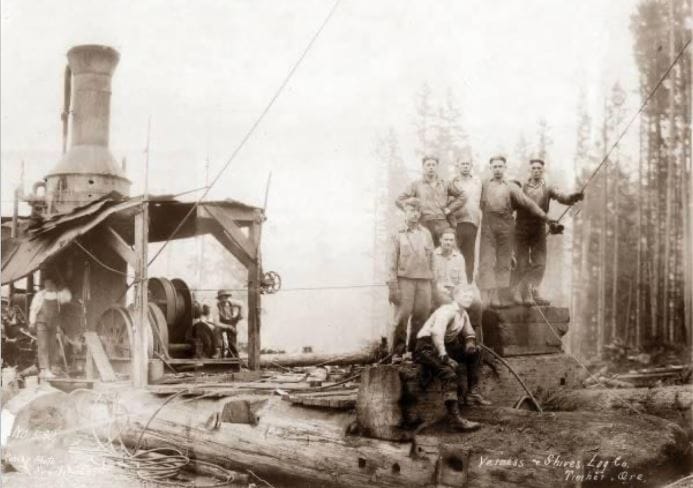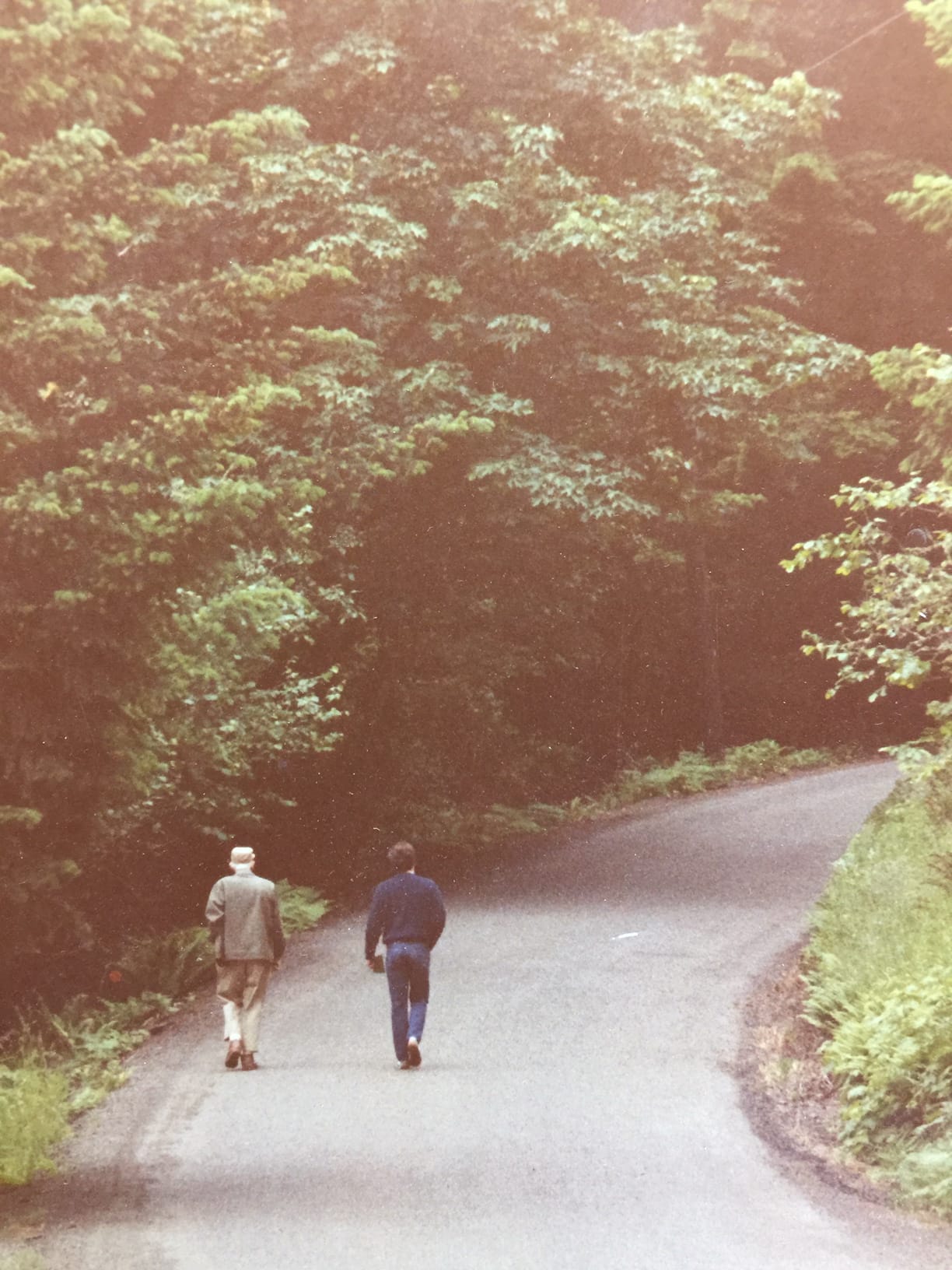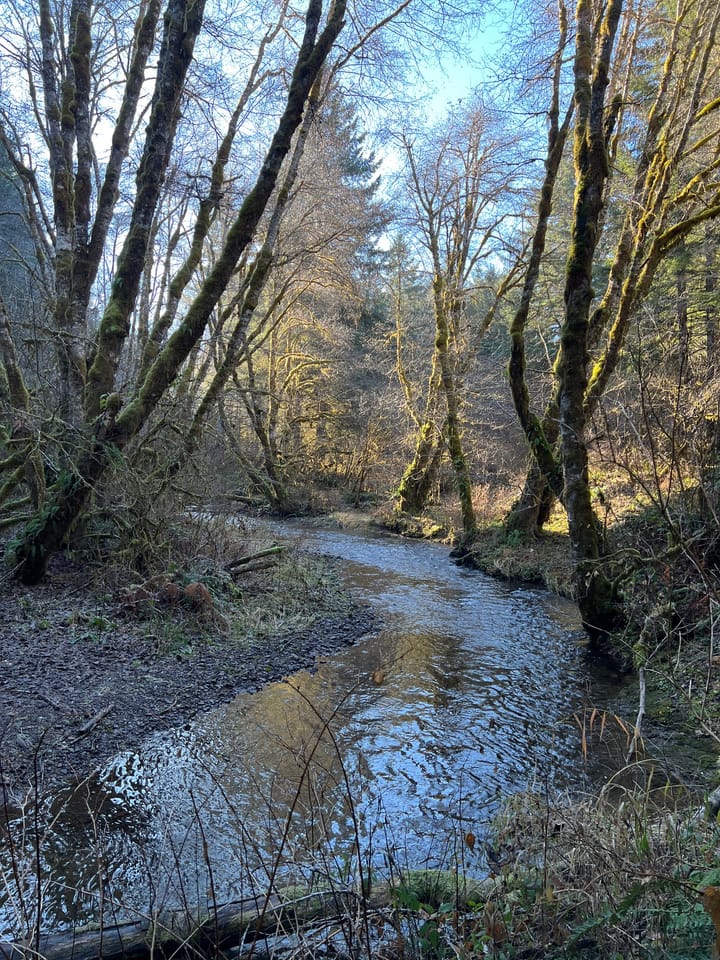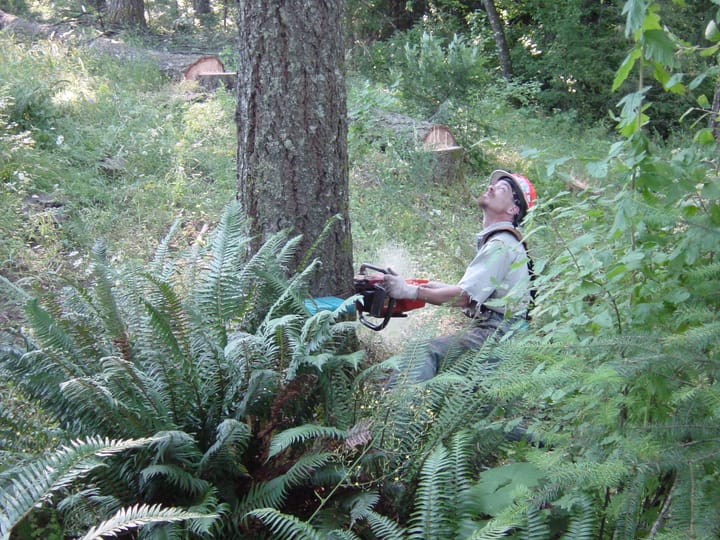Power in the Woods

Forests are all about energy. The story continues to evolve; will we?
On the wall beside where I type hangs a photograph that sustains my memories. In it, my eighty year old grandfather walks away from the camera down a narrow, forest-flanked road. My twenty year old self walks beside him. It was taken in 1976. He knew valuable things and I, in contrast, didn’t know much.

This photo anchors the reflections that lead me to the following conclusions:
- Sources and forms of energy play a key role in shaping relationships between people and forests.
- There always have been and will be changes in the forms of energy driving human use of forests.
- While some of these changes come incrementally and predictably other transitions have been and will be rapid and less predictable.
- Those of us navigating these changes have choices to make and we are likely to create better outcomes for ourselves and others when we work proactively to anticipate, understand, and prepare for the transitions than when we don’t.
My family, like all families, has navigated transitions and know that we can count on encountering more. By chance, one of the forms of change that our family has participated in involves the forms of energy that human uses of forests depend on. Any follower of recent news sees increasing questioning of what our larger energy future will – and should – be. As a member of a forest and small sawmill owning family, these questions and decisions are on my mind. I’d like them to be on your mind too.
Three photographic postcards, real and imagined, help us to explore these questions. The photos span both time and geographies. The first is the real 1976 photo hanging beside me, the second from 1910 is imagined but informed by facts, and the third is projected to be taken in the year 2036. All share in common a conversation between an eighty year old grandparent and a grandchild.
The first photo reminds me that as we walked, the sounds of logging in a nearby section of forest reached our ears. Forty years have passed since the photo was taken, but I recall the sounds being unchanged from what I hear in the woods today: the variable whine of the gas powered chainsaw, the low rumble of diesel-powered cats, skidders, and loaders, and the grind of the loaded log truck’s engine climbing up the grade from the landing headed for the mill. Once there, the logs will be cut into lumber by electric-powered saws, with the power possibly generated by steam from burned mill waste, and finely lumber heads to market on petroleum powered trucks and trains. As we walked, my grandfather shared stories of forest-related events that shaped him since he was born into a forest-connected family in 1895 on the banks of Wisconsin’s Chippewa River. During our walk, he told me of the sawmill that he and his team built just twenty miles away, in the Cascade foothills in 1931. In contrast to the loud systems we hear in the nearby forests, his operation depended on essentially no fossil fuels. Human power – fueled by oatmeal and bacon - pulled cross cut saws to fall trees and buck logs. Wood from the forest being logged powered the steam boilers of the yarder pulling logs to the landing, the trains that hauled wood to and from the mill, and the mill itself. Beginning in 1931, his Clackamas Fir Lumber Company operated at the very end of an era. By the time it closed and he opened his Row River Lumber Co. in 1939, a transformation had taken place – handsaws to chainsaws, steam donkeys to crawler tractors, trains to trucks, and steam mills to electric. A system with little dependence on fossil fuels had been replaced by one that was very dependent. Looking back, I think of the questions I wished I’d asked: what it was like to navigate his businesses and their employees through the transformation from the era of muscle and wood-fueled to the fossil fuel-dependent era?.
My grandfather was not the first member of our family to navigate a transformation in the forest sector. I like to imagine a photo that could have been taken in 1910 of two family members walking a track through the once valuable and remarkable, but now cut over, White Pine forests of the Upper Mississippi. Like the 1976 photo, I imagine my then fifteen year old grandfather walking beside his eighty year old grandfather, Orrin H. Ingram. The photo below, taken in 1905, might help your imagination. In it, the grandson, my grandfather, sits in the lower left and his grandfather sits in the upper right.
My grandfather was familiar with the systems commonly used in logging and sawmilling operations at that time. Men pulled cross cut saws to fall trees and buck logs – steam donkey winches, invented in NW California in 1881, pulled logs to landings and loaded them onto wood fueled steam trains – steam power drove both the mills and the trains that hauled the lumber to market. The entire system was driven by organisms grown in or near the forest. I imagine that during their walk the grandson might have asked his grandfather about the changes he had seen during his long and energetic career. Though the two walked near the riverbank on which the grandfather had built a sawmill in 1857, fifty three years earlier and shortly before the Civil War, the systems used for logging, transport and milling changed dramatically during that time. Orrin Ingram was only twenty seven when he and his wife arrived by horse drawn wagon or sleigh in the White Pine forests of the upper Mississippi, but he was already a seasoned operator and builder of sawmills – stretching from the Adirondacks across the northern shores of the Great Lakes. His business success depended on an era of muscle and water power. Using systems that he helped to develop and refine, humans cut trees and bucked logs – oxen or horses hauled them across the snow in the frozen forest to river banks – once thawed in spring, logs floated with the current to the mill – and lumber reached markets by being floated in huge rafts down the Chippewa and Mississippi Rivers to buyers downstream. While sawmills were driven by steam created from burning wood, most of the energy driving this system came from the combination of animal muscle and flowing water. The end of this era was triggered, in large part, by the advent of rail and the connection of Eau Claire to the rest of the country’s rail network in 1871. How I wish I could have listened and learned as my great great grandfather told my grandfather of the transformations he had navigated.
The two scenes I’ve described, one captured on film and the other conjured from facts and imagination, show us two transformations between what might be considered three eras of energy in the woods – 1) muscle and water, to 2) wood fired, and to 3) fossil fuel-dependent. Like all transformations, these were driven by a number of factors. Innovations in technologies were obviously central, but other essential ingredients included human motivation to provide for themselves and accumulate wealth and the larger systems on which practical application of the innovations depended, such as the building of railroad networks and systems for extracting and refining oil and transporting fuel to the where it was needed. Additionally, public policy, in many forms, played a role in either accelerating or slowing these transformations, in many forms including subsidies and investments. These policies were and are a manifestation of both public opinion and the impacts of corporate lobbying. I assume that with the two transformations that my family participated in there were those who looked to the future, anticipated and studied what was coming and worked to strategically not just survive, but benefit from, the changes and those who didn’t, due to choice or circumstances.
Reading today’s headlines and news, I find it hard not to conclude that when it comes to energy in the woods, we have entered into the beginning of a third transformation of similar or greater magnitude. Though clever, new technologies have postponed peak oil and accessed new fossil resources, the sun seems to be setting on our high level of dependence on fossil fuels. Additionally, each day the evidence becomes clearer that the negative consequences of releasing carbon into the atmosphere through the burning of fossil fuels, are changing life on earth and limiting options for us and future generations. Changes are accelerating and many correctly remind us that “later is no longer an option”. In the course of my forest work, I am encouraged by many encounters with resourceful people and businesses exploring alternatives in spite of the challenges and uncertainties.
There is no way of knowing whether I will see an eightieth year and, if so, whether I’ll have the chance to walk down a forest bordered pathway while talking with a grandchild. In spite of all of those “ifs”, let’s imagine such a photo taken in 2036. It seems safe to assume that forests and people will still be interacting with one another and we can be certain that both will have been changed by events in the intervening twenty six years between now and then. While listing certainties, I believe that if my grandchild asks I will have a story to share about the transformation in the world of forests and wood from the fossil fuel-dependent era to whatever emerged from it. I expect my grandchild might laugh when I describe how clunky, weak and expensive the first electric chainsaws were back in 2020 or the amount of diesel fuel that had to be hauled up to power a logging operation each morning. Will the future bring greater electrification to all parts of the system? Undoubtedly. Just look at the electric semis being tested today. Will that electricity be generated by many non-fossil fuel sources? Yes. Will we find ways to make much more efficient use of fossil fuels as use tapers off? For sure. Hybrid processors built in Scandinavia show how logging can be done burning a fraction of the fuel. Will mistakes be made along the way? It is inevitable when testing new alternatives. Will power sources be more numerous and nuanced than only electric batteries? I hope so. But there is no way to know. All across the world, these innovations are quietly moving forward. Some rely on non-fossil energy while others make super efficient use of fossil fuels. Tempting though it is to buy into notions of forward progress elevating us above what some consider a primitive past, I find it appropriate to work hard to learn about and from the lessons of the preceding eras. We have much to learn and I encourage us to be open to the possibility that the most promising aspects of our next era may include modernized applications of power sources on which past eras depended. If so, perhaps an attitude of “forward to the past” might serve us well. One example of this is how increasingly well horse logging is suited to certain circumstances. Considering the twenty six years lying between today and that scene, I wonder about ways that choices we and our businesses will make in the coming months and years might earn us respect for choosing the more constructive road of proactive anticipation, learning, imagination, and cooperative leadership. We have no choice but to navigate the transformation, but we can choose the role that we want to play in shaping and encouraging it.
There are ways that the current transformation is similar to the preceding two, but there are two significant ways that it is different. With the first two, there was little pressure driving the rate of change, instead it happened at the pace that emerging technologies and related networks allowed. In contrast, the science is clear that there are good reasons to move beyond our dependence on fossil fuels - soon. The transformations of my great great grandparents’ and grandparents’ times were driven primarily by innovations with little, or no, moral and ethical dimensions. In contrast, while technological innovations play a major role in how practices will change during the current transformation, moral and ethical questions are central to questions of whether and why our systems will change. There are clear questions of right and wrong which are inescapable in spite of the daunting complexities of the decisions facing us. We each have the opportunity to choose what is right and wrong - for us and to encourage others to do the same. Knowing that the end of the fossil fuel-dependent era is in sight, what will the emerging era hold and how will we shape it to serve us, the planet, and all who will follow as well as possible? It is an exciting and important time to be working with forests, wood, and the energy sources that we all depend on.


